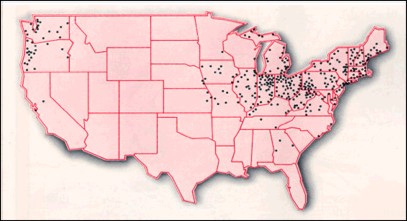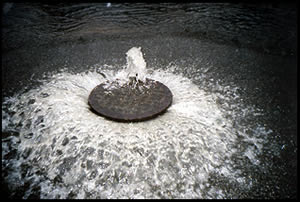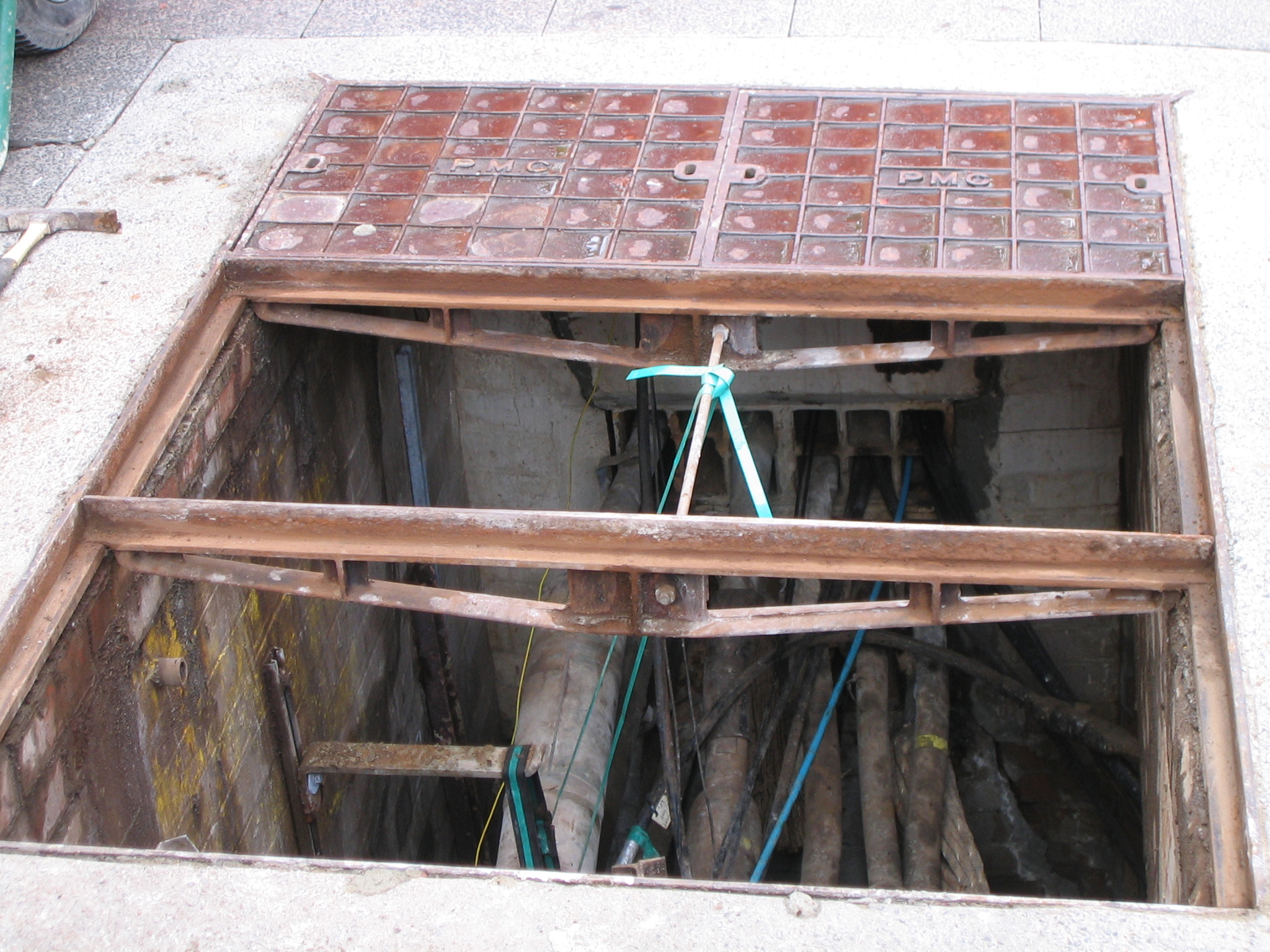|
Sewerage
Sewerage (or sewage system) is the infrastructure that conveys sewage or surface runoff (stormwater, meltwater, rainwater) using sewers. It encompasses components such as receiving drainage, drains, manholes, pumping stations, storm overflows, and screening chambers of the combined sewer or sanitary sewer. Sewerage ends at the entry to a sewage treatment plant or at the point of discharge into the Natural environment, environment. It is the system of pipes, chambers, manholes, etc. that conveys the sewage or storm water. In many cities, sewage (or municipal wastewater) is carried together with stormwater, in a combined sewer system, to a sewage treatment plant. In some urban areas, sewage is carried separately in sanitary sewers and runoff from streets is carried in storm drains. Access to these systems, for maintenance purposes, is typically through a manhole. During high precipitation periods a sewer system may experience a combined sewer overflow event or a sanitary sewer over ... [...More Info...] [...Related Items...] OR: [Wikipedia] [Google] [Baidu] |
Simplified Sewerage
Simplified sewerage, also called small-bore sewerage, is a sanitary sewer, sewer system that collects all household wastewater (blackwater (waste), blackwater and greywater) in small-diameter pipes laid at fairly flat gradients. Simplified sewers are laid in the front yard or under the pavement (sidewalk) or - if feasible - inside the back yard, rather than in the centre of the road as with conventional sewerage. It is suitable for existing unplanned low-income areas, as well as new housing estates with a regular layout. It allows for a more flexible design. With simplified sewerage it is crucial to have management arrangements in place to remove blockages, which are more frequent than with conventional sewers. It has been estimated that simplified sewerage reduces investment costs by ''up to'' 50% compared to conventional sewerage. Simplified sewerage is sometimes also referred to as conventional sewerage with appropriate standards, implying that most conventional sewers are overd ... [...More Info...] [...Related Items...] OR: [Wikipedia] [Google] [Baidu] |
Sanitary Sewer
A sanitary sewer is an underground pipe or tunnel system for transporting sewage from houses and commercial buildings (but not stormwater) to a sewage treatment plant or disposal. Sanitary sewers are a type of gravity sewer and are part of an overall system called a "sewage system" or sewerage. Sanitary sewers serving industrial areas may also carry industrial wastewater. In municipalities served by sanitary sewers, separate storm drains may convey surface runoff directly to surface waters. An advantage of sanitary sewer systems is that they avoid combined sewer overflows. Sanitary sewers are typically much smaller in diameter than combined sewers which also transport urban runoff. Backups of raw sewage can occur if excessive stormwater inflow or groundwater infiltration occurs due to leaking joints, defective pipes etc. in aging infrastructure. Purpose Sewage treatment is less effective when sanitary waste is diluted with stormwater, and combined sewer overflows occur when r ... [...More Info...] [...Related Items...] OR: [Wikipedia] [Google] [Baidu] |
Storm Drain
A storm drain, storm sewer (United Kingdom, United States, U.S. and Canada), surface water drain/sewer (United Kingdom), or stormwater drain (Australia and New Zealand) is infrastructure designed to Drainage, drain excess rain and ground water from impervious surfaces such as paved streets, car parks, parking lots, footpaths, sidewalks, and roofs. Storm drains vary in design from small residential dry wells to large municipal systems. Drains receive water from street gutters on most motorways, freeways and other busy roads, as well as towns in areas with heavy rainfall that leads to flooding, and coastal towns with regular storms. Even gutters from houses and buildings can connect to the storm drain. Many storm drainage systems are gravity sewers that drain untreated storm water into rivers or streams—so it is unacceptable to pour hazardous substances into the drains. Storm drains sometimes cannot manage the quantity of rain that falls in heavy rains or storms. Inundated drai ... [...More Info...] [...Related Items...] OR: [Wikipedia] [Google] [Baidu] |
Stormwater
Stormwater, also spelled storm water, is water that originates from precipitation (storm), including heavy rain and meltwater from hail and snow. Stormwater can soak into the soil ( infiltrate) and become groundwater, be stored on depressed land surface in ponds and puddles, evaporate back into the atmosphere, or contribute to surface runoff. Most runoff is conveyed directly as surface water to nearby streams, rivers or other large water bodies (wetlands, lakes and oceans) without treatment. In natural landscapes, such as forests, soil absorbs much of the stormwater. Plants also reduce stormwater by improving infiltration, intercepting precipitation as it falls, and by taking up water through their roots. In developed environments, such as cities, unmanaged stormwater can create two major issues: one related to the volume and timing of runoff (flooding) and the other related to potential contaminants the water is carrying (water pollution). In addition to the pollutants carr ... [...More Info...] [...Related Items...] OR: [Wikipedia] [Google] [Baidu] |
Storm Drain
A storm drain, storm sewer (United Kingdom, United States, U.S. and Canada), surface water drain/sewer (United Kingdom), or stormwater drain (Australia and New Zealand) is infrastructure designed to Drainage, drain excess rain and ground water from impervious surfaces such as paved streets, car parks, parking lots, footpaths, sidewalks, and roofs. Storm drains vary in design from small residential dry wells to large municipal systems. Drains receive water from street gutters on most motorways, freeways and other busy roads, as well as towns in areas with heavy rainfall that leads to flooding, and coastal towns with regular storms. Even gutters from houses and buildings can connect to the storm drain. Many storm drainage systems are gravity sewers that drain untreated storm water into rivers or streams—so it is unacceptable to pour hazardous substances into the drains. Storm drains sometimes cannot manage the quantity of rain that falls in heavy rains or storms. Inundated drai ... [...More Info...] [...Related Items...] OR: [Wikipedia] [Google] [Baidu] |
Sewage Treatment Plant
Sewage treatment (or domestic wastewater treatment, municipal wastewater treatment) is a type of wastewater treatment which aims to remove contaminants from sewage to produce an effluent that is suitable for discharge to the surrounding environment or an intended reuse application, thereby preventing water pollution from raw sewage discharges. Sewage contains wastewater from households and businesses and possibly pre-treated industrial wastewater. There are a high number of sewage treatment processes to choose from. These can range from decentralized systems (including on-site treatment systems) to large centralized systems involving a network of pipes and pump stations (called sewerage) which convey the sewage to a treatment plant. For cities that have a combined sewer, the sewers will also carry urban runoff (stormwater) to the sewage treatment plant. Sewage treatment often involves two main stages, called primary and secondary treatment, while advanced treatment also incor ... [...More Info...] [...Related Items...] OR: [Wikipedia] [Google] [Baidu] |
Combined Sewer
A combined sewer is a type of gravity sewer with a system of pipes, tunnels, pump stations etc. to transport sewage and urban runoff together to a sewage treatment plant or disposal site. This means that during rain events, the sewage gets diluted, resulting in higher flowrates at the treatment site. Uncontaminated stormwater simply dilutes sewage, but runoff may dissolve or suspend virtually anything it contacts on roofs, streets, and storage yards. As rainfall travels over roofs and the ground, it may pick up various contaminants including soil particles and other sediment, heavy metals, organic compounds, animal waste, and oil and grease. Combined sewers may also receive dry weather drainage from landscape irrigation, construction dewatering, and washing buildings and sidewalks. Combined sewers can cause serious water pollution problems during combined sewer overflow (CSO) events when combined sewage and surface runoff flows exceed the capacity of the sewage treatment plant ... [...More Info...] [...Related Items...] OR: [Wikipedia] [Google] [Baidu] |
Gravity Sewer
A gravity sewer is a conduit utilizing the energy resulting from a difference in elevation to remove unwanted water. The term ''sewer'' implies removal of sewage or surface runoff rather than water intended for use;''Design and Construction of Sanitary and Storm Sewers''(1970)p.1 and the term ''gravity'' excludes water movement induced through force mains or vacuum sewers. Most sewers are gravity sewers; because gravity offers reliable water movement with no energy costs wherever grades are favorable. Gravity sewers may drain to sumps where pumping is required to either force sewage to a distant location or lift sewage to a higher elevation for entry into another gravity sewer, and lift stations are often required to lift sewage into sewage treatment plants. Gravity sewers can be either sanitary sewers, combined sewers, storm sewers or effluent sewers. Gravity sewer hydraulics Gravity sewer systems typically resemble the regional runoff pattern with large trunk sewers in each v ... [...More Info...] [...Related Items...] OR: [Wikipedia] [Google] [Baidu] |
Combined Sewer Overflow
A combined sewer is a type of gravity sewer with a system of pipes, tunnels, pump stations etc. to transport sewage and urban runoff together to a sewage treatment plant or disposal site. This means that during rain events, the sewage gets diluted, resulting in higher flowrates at the treatment site. Uncontaminated stormwater simply dilutes sewage, but runoff may dissolve or suspend virtually anything it contacts on roofs, streets, and storage yards. As rainfall travels over roofs and the ground, it may pick up various contaminants including soil particles and other sediment, heavy metals, organic compounds, animal waste, and oil and grease. Combined sewers may also receive dry weather drainage from landscape irrigation, construction dewatering, and washing buildings and sidewalks. Combined sewers can cause serious water pollution problems during combined sewer overflow (CSO) events when combined sewage and surface runoff flows exceed the capacity of the sewage treatment plant ... [...More Info...] [...Related Items...] OR: [Wikipedia] [Google] [Baidu] |
Sanitary Sewer Overflow
Sanitary sewer overflow (SSO) is a condition in which untreated sewage is discharged from a sanitary sewer into the environment prior to reaching sewage treatment facilities. When caused by rainfall it is also known as wet weather overflow. Causes of sanitary sewer overflows include: Blockage of sewer lines, infiltration/Inflow of excessive stormwater into sewer lines during heavy rainfall, malfunction of pumping station lifts or electrical power failure, broken sewer lines. Prevention of such overflow events involves regular maintenance and timely upgrades of infrastructure. SSOs can cause gastrointestinal illnesses (waterborne diseases), beach closures and restrictions on fish and shellfish consumption. Magnitude of the problem Developed countries such as the United States, Canada, most Western European nations (e.g. Italy and France), Australia, Singapore, South Korea and Japan are struggling with public health problems of SSO prevention. The magnitude of the problem is much g ... [...More Info...] [...Related Items...] OR: [Wikipedia] [Google] [Baidu] |
Combined Sewer
A combined sewer is a type of gravity sewer with a system of pipes, tunnels, pump stations etc. to transport sewage and urban runoff together to a sewage treatment plant or disposal site. This means that during rain events, the sewage gets diluted, resulting in higher flowrates at the treatment site. Uncontaminated stormwater simply dilutes sewage, but runoff may dissolve or suspend virtually anything it contacts on roofs, streets, and storage yards. As rainfall travels over roofs and the ground, it may pick up various contaminants including soil particles and other sediment, heavy metals, organic compounds, animal waste, and oil and grease. Combined sewers may also receive dry weather drainage from landscape irrigation, construction dewatering, and washing buildings and sidewalks. Combined sewers can cause serious water pollution problems during combined sewer overflow (CSO) events when combined sewage and surface runoff flows exceed the capacity of the sewage treatment plant ... [...More Info...] [...Related Items...] OR: [Wikipedia] [Google] [Baidu] |
Manhole
A manhole (utility hole, maintenance hole, or sewer hole) is an opening to a confined space such as a shaft, utility vault, or large vessel. Manholes are often used as an access point for an underground public utility, allowing inspection, maintenance, and system upgrades. The majority of underground services have manholes, including water, sewers, telephone, electricity, storm drains, district heating, and gas. Manholes are generally found in urban areas, in streets and occasionally under sidewalks. In rural and undeveloped areas, services such as telephone and electricity are usually carried on utility poles or even pylons rather than underground. In Australia, ''manhole'' also commonly refers to an access hatch used to get access from a room or hallway into the ceiling cavity of a building. These manholes are typically around square. Construction Manhole closings are protected by a grating or manhole cover, a flat plug designed to prevent accidental or unauthorize ... [...More Info...] [...Related Items...] OR: [Wikipedia] [Google] [Baidu] |





_01.jpg)
